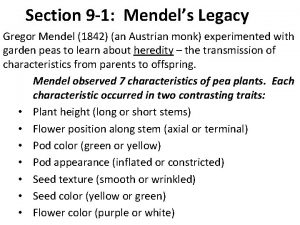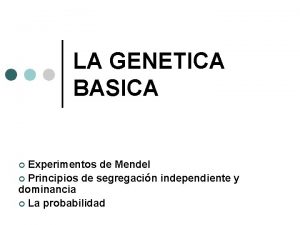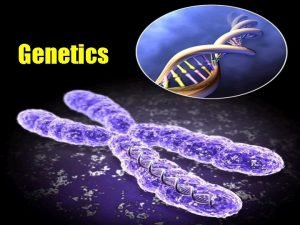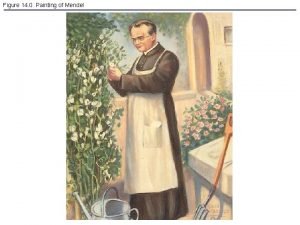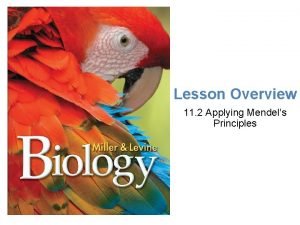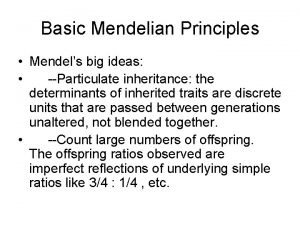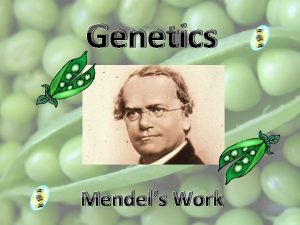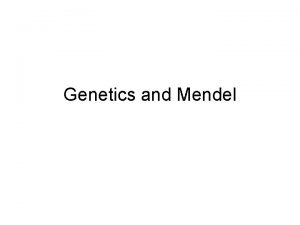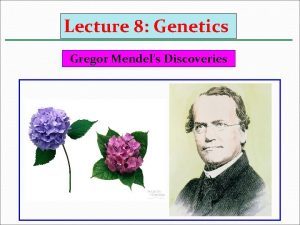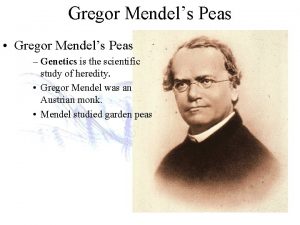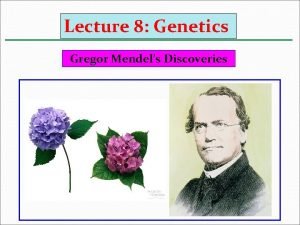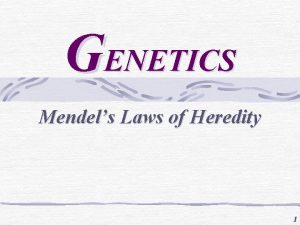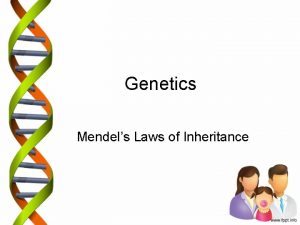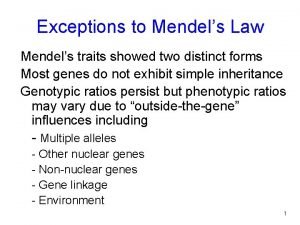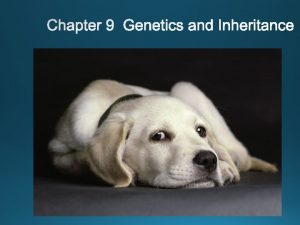History of Genetics Mendels Work What is Genetics















- Slides: 15

History of Genetics Mendel’s Work

What is Genetics? • The science of Heredity • The way by which traits are passed from parent to offspring, or “inherited”

Who was Mendel? • Gregor Mendel was an Austrian monk who was the first to understand certain patterns of inheritance • He did so by crossing different types of pea plants in carefully planned experiments

Why pea plants? • 1. ) They have many different characteristics that have two distinct forms

Why pea plants? • 1. ) They have many different characteristics that have two distinct forms • 2. ) They are self-pollinating (can fertilize themselves) because each flower has both male and female parts

Why pea plants? • 1. ) They have many different characteristics that have two distinct forms • 2. ) They are self-pollinating (can fertilize themselves) because each flower has both male and female parts • 3. ) They are “low maintenance” plants – Easy to care for – Rapid life cycle

Mendel’s Experiment • Mendel performed crosses only looking at one trait: MONOHYBRID CROSS • Step 1: Mendel allowed plants that had each type of trait to self-pollinate for several generations (to ensure the production true-breeds). P generation • Step 2: Mendel crossed two P generation plants that had “opposite” traits. Produced F 1 generation • Step 3: Mendel allowed F 1 generation to self-pollinate. Produced F 2 generation

Mendel’s Experiment • After each pollination, Mendel recorded the number of plants that had each trait

Results to Note: • When Mendel crossed true breed purple flowers with true breed white flowers, all of the offspring in the F 1 generation had purple flowers. • After the F 1 generation was left to self-pollinate, the F 2 generation resulted in 705 purple flowered plants and 224 white flowered plants • Ratio= 705: 224 OR 3: 1 • This 3: 1 ratio was seen in all seven of the traits.

Hypotheses Based on Mendel’s Results: • 1. ) For each inherited trait, an individual has two copies of the gene – one from each parent. • 2. ) There alternative versions of genes called alleles. • 3. ) When two different alleles are present together, one of them might be completely expressed, while the other may have no effect on the physical appearance. – Expressed trait = dominant (capital letter) – Trait not expressed when dominant is present = recessive (lower case letter)

What did Mendel Think of All This? • Mendel correctly concluded that each pea has two separate “heritable factors” for each trait – one from each parent

Homozygous vs. Heterozygous • If the two alleles of a particular gene present in an individual are the same, the individual is said to be homozygous § If the alleles of a particular gene present in an individual are different, the individual is said to be heterozygous

Working with Mendel’s Rules of Genetics: • All of Mendel’s work was based upon a mathematical field that deals with how likely something is to happen, called probability • We now use devices called Punnett squares to calculate these probabilities

Working with Mendel’s Rules of Genetics: • How to set up a monohybrid Punnett square: – Draw a square and divide it into 4 squares. – Collect Parental information (Tt x tt) – Place one letter from first parent beside each row; place one letter from second parent above each column: t t – Multiply to fill each sq. T T t t t t

Working with Mendel’s Rules of Genetics: • Calculate a genotypic ratio: Genotype is genetic make-up – In this case, each offspring has a 50% chance of having the genotype Tt and a 50% chance of having the genotype tt • Calculate a phenotypic ratio: Phenotype is the physical representation of t t the gene – In this case, each offspring has T a 50% chance of being able to t roll their tongue and a 50% chance of not being able to T t t t
 Gregor mendels principles of genetics apply to
Gregor mendels principles of genetics apply to Who was mendal
Who was mendal Section 9-1 review mendel's legacy
Section 9-1 review mendel's legacy Andalusian chicken incomplete dominance
Andalusian chicken incomplete dominance Chapter 12 lesson 2 applying mendels principles
Chapter 12 lesson 2 applying mendels principles Leyes de mendel
Leyes de mendel What is codominance in biology
What is codominance in biology Gregor mendel data
Gregor mendel data Mendels law of segregation states that
Mendels law of segregation states that Mendels law
Mendels law Chapter 12 lesson 2 applying mendel's principles
Chapter 12 lesson 2 applying mendel's principles Mendels two laws
Mendels two laws Mendel's first law
Mendel's first law Mendel laws
Mendel laws Chapter 12 lesson 2 applying mendels principles
Chapter 12 lesson 2 applying mendels principles Mendels fabric
Mendels fabric


